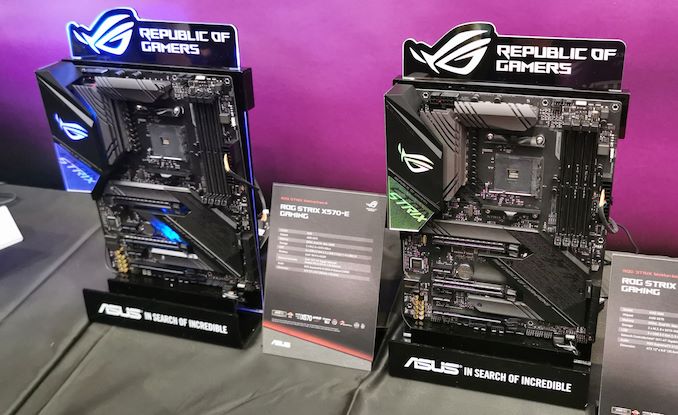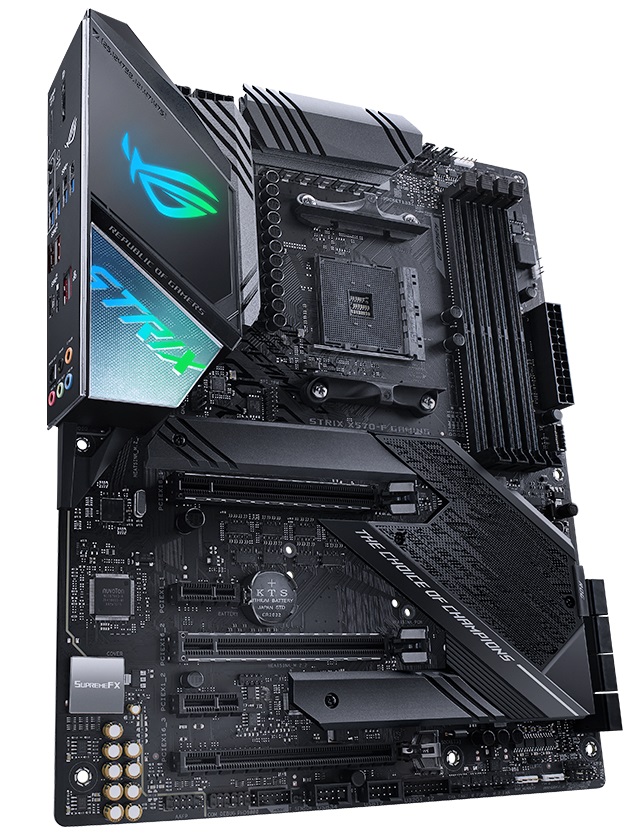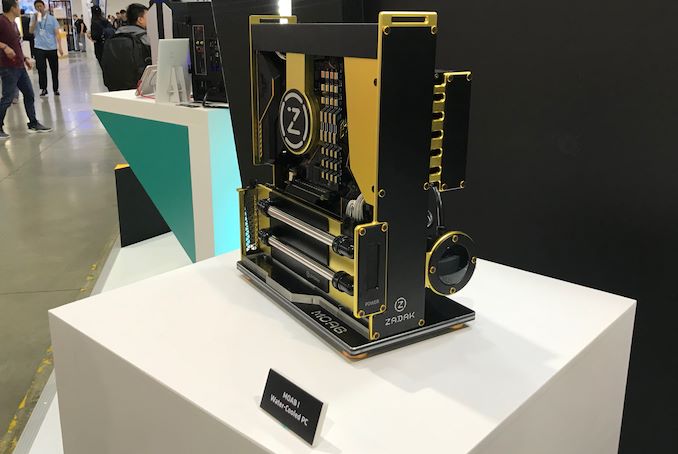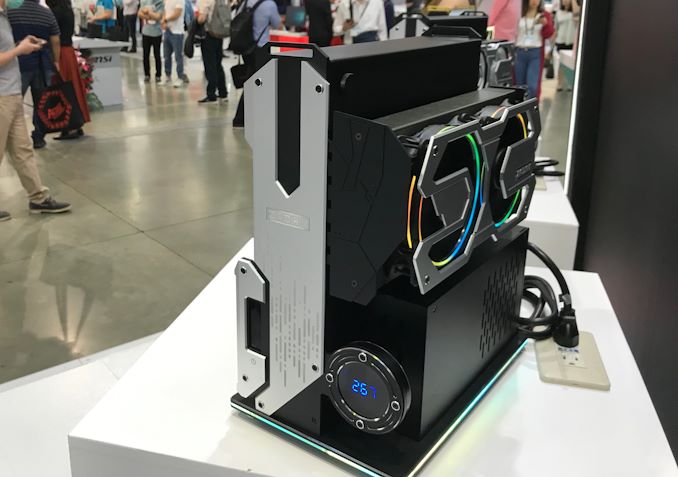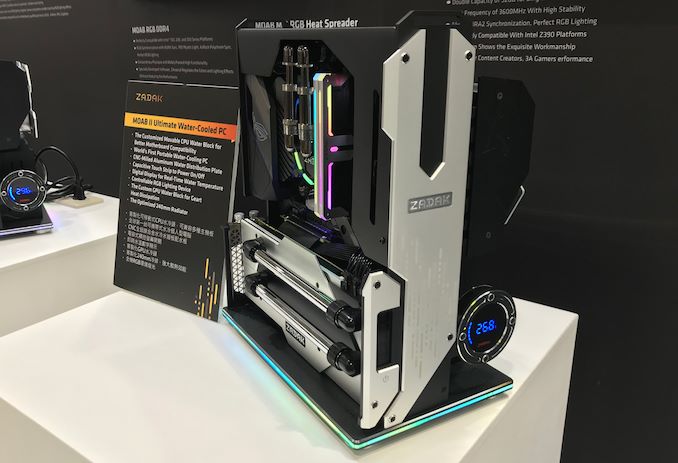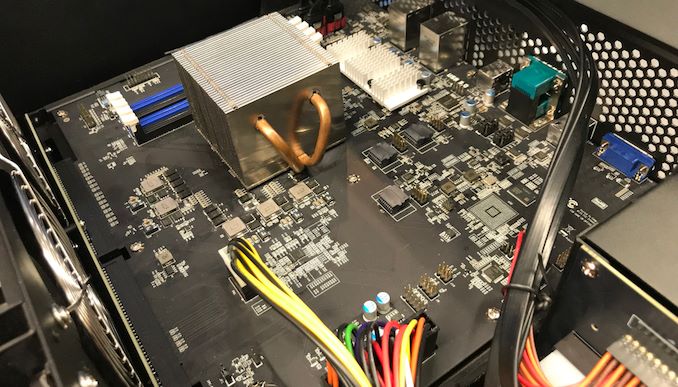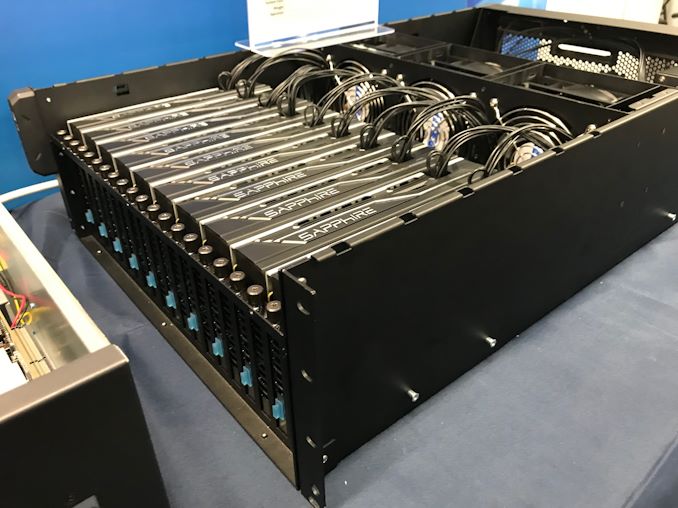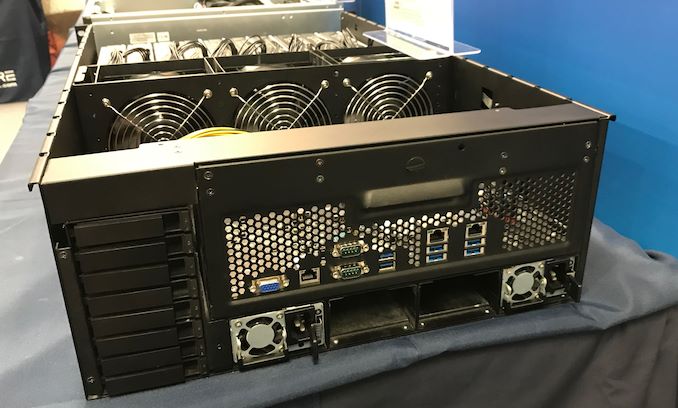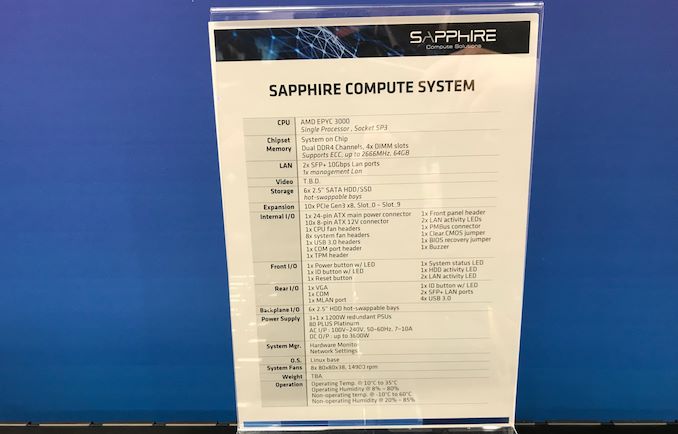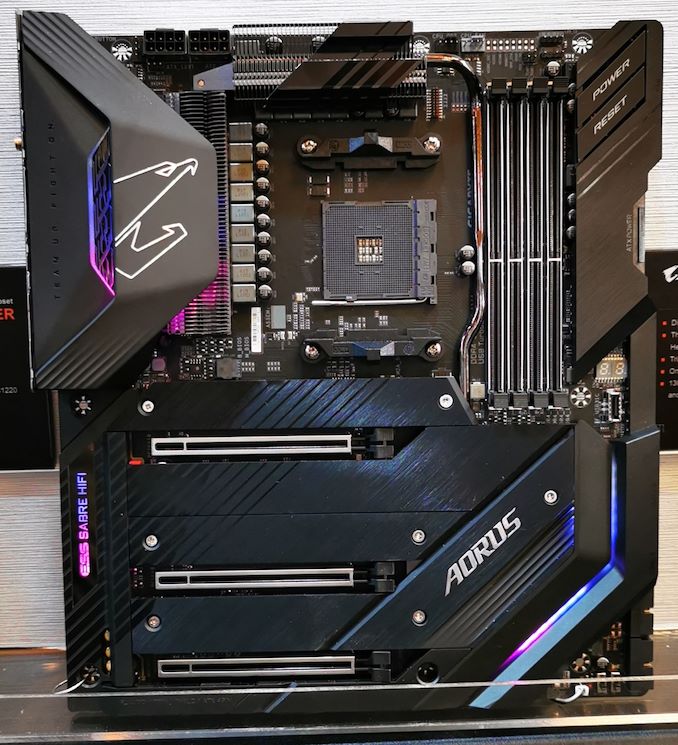Friday 31 May 2019
ASUS ROG Strix X570-E and ROG Strix X570-F Gaming Motherboards Announced
ASUS has unveiled a number of X570 motherboard at Computex 19 with a range of boards in different price brackets. Also announced is the ROG Strix X570-E Gaming and the ROG Strix X570-F which feature similar aesthetics, but differ slighting in terms of features.
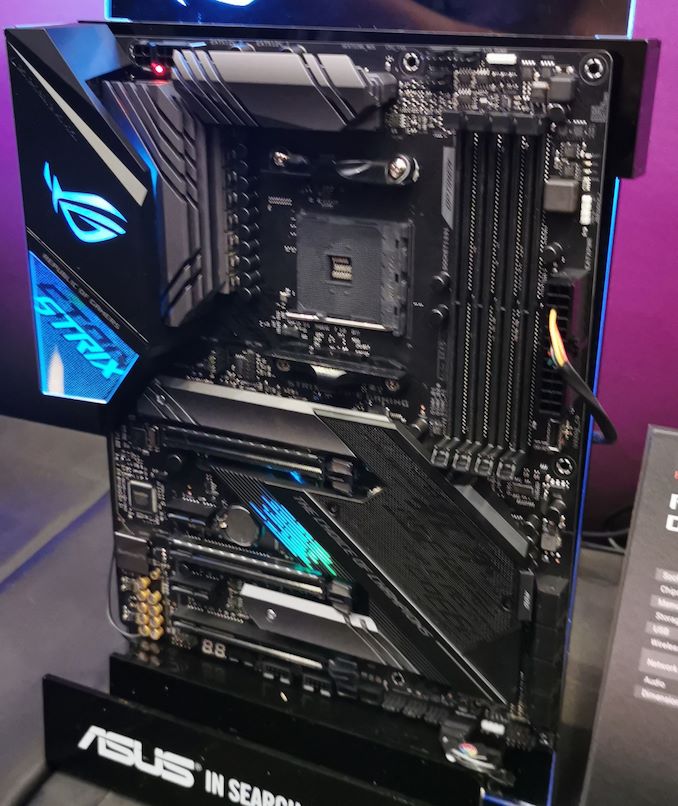
ASUS ROG Strix X570-E Gaming - apologies for the blurry picture, we'll update it when we visit ASUS later this week
Starting with the higher spec model of the pairing, the ASUS ROG Strix X570-E includes the gaming-focused Realtek RTL8125G 2.5 GbE LAN with a second port controlled by an Intel I211-AT Gigabit controller, with the wireless capabilities coming from the new Intel AX200 Wi-Fi 6 802.11ax adapter. The board boasts three full-length PCIe 4.0 slots which operate at x16, x8/x8, and x8/x8/x4, with the final four being from the chipset. The Strix themed chipset heatsink has two M.2 heatsinks emanating from the top and bottom side for the boards dual PCIe 4.0 M.2, with a cooling fan integrated which is designed to keep the X570 chipset cool. The ROG Strix X570-E also has eight SATA ports and four DDR4 memory slots.

ASUS ROG Strix X570-E Gaming rear panel
Also featured are seven USB 3.1 G2 Type-A, one USB 3.1 G2 Type-C, and four USB 3.1 G1 Type-A ports on the rear panel. A SupremeFX S1220 HD audio codec adds five color-coded 3.5 mm jacks, and an S/PDIF optical out. A pair of video outputs consisting of an HDMI 2.0 and DisplayPort 1.2 output is present and for use with the Ryzen APUs.
On the PCB of the ASUS ROG Strix X570-F Gaming is three full-length PCIe 4.0 ports which are configured to run at x16, x8/x8, and x8/x8/x4. Also featured is two PCIe 4.0 M.2 slots with a pair of M.2 heatsinks which is likely to be needed to run the latest PCIe 4.0 x4 SSDs. The board also includes eight SATA ports and four DDR4 memory slots.
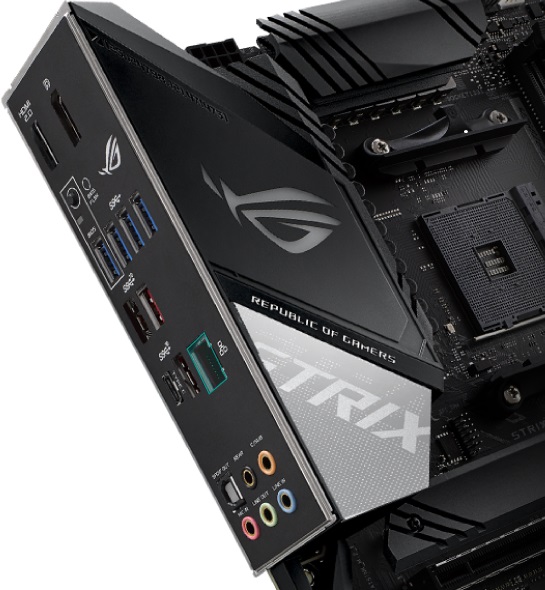
ASUS ROG Strix X570-F Gaming rear panel
The ASUS ROG Strix X570-F drops the Wi-Fi capability and just uses a single Intel I1211-AT Gigabit powered LAN port. While both models share the same SupremeFX S1220 HD audio codec, the Strix X570-F has less USB 3.1 G2, with just three USB 3.1 Type-A, and one USB 3.1 G2 Type-C on the rear panel. This also includes four USB 3.1 G1 Type-A ports.
Both the ASUS ROG Strix X570-E and Strix X570-F Gaming motherboards are expected to be available prior to the launch of AMD's Ryzen 3000 series processors on 7/7. Pricing information is currently unknown, but it is likely to be announced closer to the launch of the chipset.
| Want to keep up to date with all of our Computex 2019 Coverage? | ||||||
 Laptops |
 Hardware |
 Chips |
||||
| Follow AnandTech's breaking news here! | ||||||
from AnandTech http://bit.ly/2IeicC4
via IFTTT
The 5 best components of Computex 2019: the coolest chips and drives
We’ve been in Taiwan at Computex 2019, checking out what tech companies envision for the future of computing gadgets. There, manufacturers have shown off new laptops, monitors, desktop computers and, most importantly, a whole host of components that can go inside.
With so many new components appearing at Computex, it can be easy to lose track of the biggest and most exciting ones. So, we’ve set out to round up our picks for the best revealed at the show, letting you find them all in one place. Here, we’ll lay out al the best PC components from Computex 2019, so you can start planning your next PC build or get excited for future devices.
Check out all of TechRadar's Computex 2019 coverage. We're live in Taipei to bring you all the breaking computing news and launches, plus hands-on reviews of everything from fresh laptops and desktops to powerful new components and wild overclocking demonstrations.
AMD was all but guaranteed to dominate Computex 2019, thanks to the anticipated announcements of 3rd-Generation Ryzen processors (CPUs) built on the 7-nanometer (nm) Zen 2 architecture. And, AMD delivered. The new Ryzen 3rd-Gen chips were announced with staggering core counts up to 12 cores and 24 threads.
The company is launching the new CPUs on July 7, and has an initial lineup of an 8-core Ryzen 7 3700X at $329 (about £260 or AU$475), a 10-core Ryzen 7 3800X at $399 (about £315 / AU$575), and the 12-core Ryzen 9 3900X at $499 (about £395 / AU$720). In a benchmark, the Ryzen 7 3800X went toe-to-toe with the Intel Core i9-9900K and performed evenly while costing substantially less.
The launch of an AMD Navi graphics card was just a sweet little extra.
A new era of storage speed is coming by way of PCIe 4.0, the new interface coming to motherboards with incredible bandwidth. And, taking advantage of the new interface’s speeds is Gigabyte’s Aorus NVMe SSD, which can outpace previous SSDs by over 40%.
The new SSD will need a new motherboard with the PCIe 4.0 interface, but when it’s paired with one, it can hit sequential read speeds of 5,000MB/s and sequential write speeds of 4,400MB/s. That’s a huge leap over even Samsung’s new 970 Evo Plus SSD.
While Intel had some more typical computer components to show off at Computex 2019, outlining its vision for the future, the slickest among them was the Intel NUC Compute Element. The company has put out plenty of NUCs before, which have been small barebones PCs. But, this one is a small card that can slot into a chassis to easily upgrade existing hardware.
In other words, you could have a laptop with a big screen, speakers, keyboard and ports, and when it’s time to upgrade, you’d just slide out the old card and slide in the new card. Everything else would remain. The NUC Compute Element will be available in the first half of 2020.
Intel’s 10nm Ice Lake processors are finally coming, and they’ll appear in laptops later this year. While they’re not going to be your standard desktop CPUs, and they won’t go head to head with AMD’s new Ryzen CPUs, they will power capable new laptops.
But, perhaps most exciting is the trick that Ice Lake CPUs have up their sleeves. The new CPUs will come with Intel’s Gen11 graphics, which offer a substantial boost from the previous integrated graphics and may even be able to handle even some AAA PC games.
In partnership with Lenovo, Qualcomm as announced a new system-on-a-chip (SoC) called the Snapdragon 8cx. The new computing system will not only be a 7nm platform for mobile computers, but it will also deliver 5G connectivity to laptops.
While 5G is still a nascent technology, rolling out slowly and lacking anything close to the level of coverage offered by 4G LTE, it will be the future connectivity standard. Laptops with 5G connectivity built-in will be able to take advantage of the high bandwidth and low latency of the connection, making them even more capable of taking advantage of cloud computing.
from TechRadar: computing components news http://bit.ly/2JP1axD
via IFTTT
ZADAK Demonstrates MOAB: "World’s First Portable Water-Cooled PC"
In US military terminolgy, the MOAB is the Mother of All Bombs – the world’s most powerful non-nuclear bomb. Now, ZADAK is building its own MOAB (of sorts), in the form of a premium compact water-cooled PC that they are calling the MOAB.
A division of Apacer, ZADAK received a worldwide recognition last year after it released 32 GB dual-rank memory modules for ASUS Z390-based desktops. However ZADAK doesn't just do memory; the group actually has their fingers in a couple other businesses as well, particularly enthusiast-class PCs sold in Asia. So at this year's Computex, ZADAK demonstrated its previously-announced MOAB, a compact desktop that the company calls "the world’s first portable water-cooled PC".
ZADAK’s MOAB and MOAB II can be based on almost any Mini-ITX motherboard and CPU (because of movable CPU water block), so its specifications are pretty flexible here. On the flip side, however, when it comes to GPUs the PC’s liquid-cooling system is only compatible with NVIDIA’s reference design video cards.
Apart from its compact form-factor, the key selling feature of the MOAB is its open design, which makes it easy to see the hardware up-close and simplifies cooling. Following the latest trends, the PC has addressable RGB LEDs on its CPU water block, memory modules, chipset (depending on the actual motherboard used), front panel, etc. MOAB also has a LED screen displaying the cooling system's water temperature on the front.
Since MOAB can be extensively configured, the prices of complete systems vary greatly. At present, ZADAK’s MOAB is only available in Asia, but the company is looking forward to bring it to other markets in the near future.
| Want to keep up to date with all of our Computex 2019 Coverage? | ||||||
 Laptops |
 Hardware |
 Chips |
||||
| Follow AnandTech's breaking news here! | ||||||
from AnandTech http://bit.ly/2KhiR8z
via IFTTT
Sapphire Shows Off 10-Way GPU Compute System with AMD EPYC 3000
Cryptocurrency mining boom may be over, but there are many applications that can take advantage of GPU compute horsepower besides mining. Sapphire has demonstrated its upcoming GPU compute system featuring 10 graphics cards at Computex.
Based on AMD’s EPYC 3000-series embedded processor, the 10-way GPU compute machine has 10 PCIe 3.0 x8 slots connected to the CPU via five PCIe switches from ASMedia. The system is outfitted with six 2.5-inch bays for storage devices, two 10 GbE LAN ports with SFP+ connectors, six USB ports, two COM connectors, a TPM header, and so on (check the exact specs on the image below). The server can be powered using up to four PSUs (3+1 redundant), but the static demo only had two 1200 W PSUs.
Sapphire demonstrated its 10-way GPU compute system with 10 Radeon RX 470 graphics cards, but it can naturally install almost any boards inside provided that they feature an appropriate cooling system and design.
Sapphire still has not decided when the 10-way GPU compute system is set to be available and how much it is set to cost, so we will not speculate.
| Want to keep up to date with all of our Computex 2019 Coverage? | ||||||
 Laptops |
 Hardware |
 Chips |
||||
| Follow AnandTech's breaking news here! | ||||||
from AnandTech http://bit.ly/2wwoo30
via IFTTT
Intel Publishes Plans to Wind Down Shipments of 7th Gen Core "Skylake-X" HEDT Processors
With Intel’s announcement this week that they will be releasing a new generation of Core X-series high-end desktop (HEDT) processors this fall, the company has also begun working on their plans to phase out the previous generation of HEDT processors. Revealed this week in a product change notification on Intel’s website, the company will soon be winding down production and shipment of their 7th Gen Core “Skylake-X” processors, with the final chips shipping next spring.
Intel’s Skylake-X processors first launched almost two years ago, as the Core i7/i9 7800X & 7900X series of parts. Intel’s first HEDT design based on their Skylake CPU architecture, the chips came in configurations ranging from a 6 core processor up to a might 18 core processor. However these chips were replaced as Intel’s flagship line of parts in late 2018 with the 9th Gen Core “Skylake-X Refresh” family of chips, which iterated on the design for improved clockspeeds. As a result, the original 7th Gen Core Skylake-X chips have already been on their way out, from a consumer product standpoint.
Now Intel will make that phase-out official, starting later this year. As per the PCN, Intel’s clients will need to make final orders for these CPUs by December 27, 2019. Intel, in turn, will ship their last batch of orders by June 5, 2020.
By mid-2020, Intel should already be well in the middle of shipping their future Core X-series family of parts, never mind the soon-to-be-dated 9th Gen Core parts. So this week’s note to customers is consistent with Intel’s normal production plans; the company generally prefers to only be producing a couple generations of HEDT parts at once.
Related Reading:
- Intel's Basin Falls Skylake-X Refresh: Core i9-9980XE with up to 15% Better Power Efficiency
- Intel Finalizes Skylake-X Processor Specifications: 18-Cores, 4.4 GHz Turbo, 165W on September 25th
Source: Intel
from AnandTech http://bit.ly/2MkXFkR
via IFTTT
PCIe 5.0 specification announced, will bring 128GB/s transfer speeds
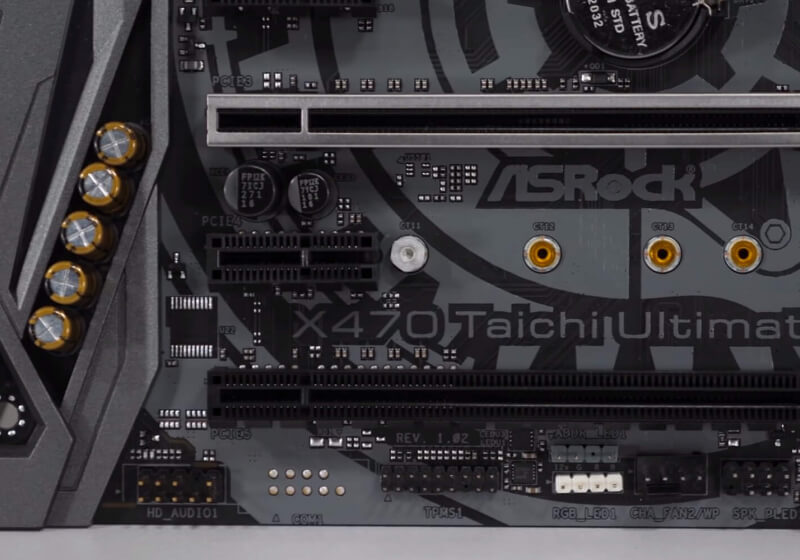
AMD’s new X570 chipset, designed for the upcoming Ryzen 3000 series CPUs, comes with PCIe 4.0 support, enabling hardware such as Gigabyte’s Aorus AIC Gen4—a PCIe 4.0-based SSD card that can reach read speeds of 15 GB/s when running in a RAID 0 configuration. But PCI-SIG isn’t standing still—the consortium...


from TechSpot http://bit.ly/2QBWZpA
via IFTTT
Have we reached peak RGB at Computex 2019?
In 2019, PC gaming is all about the RGB lighting. Basically every peripheral and component features extraneous lighting from every corner. Now, we here at TechRadar love flashy hardware as much as anyone, but when are we, as a collective, going to say "enough is enough"?
We think we've basically reached the point where everything attached to your PC could conceivably be RGB, and we're going to walk through all the crazy RGB accessories we saw at Computex 2019, to help paint a picture of how many different products use the fancy colored lights.
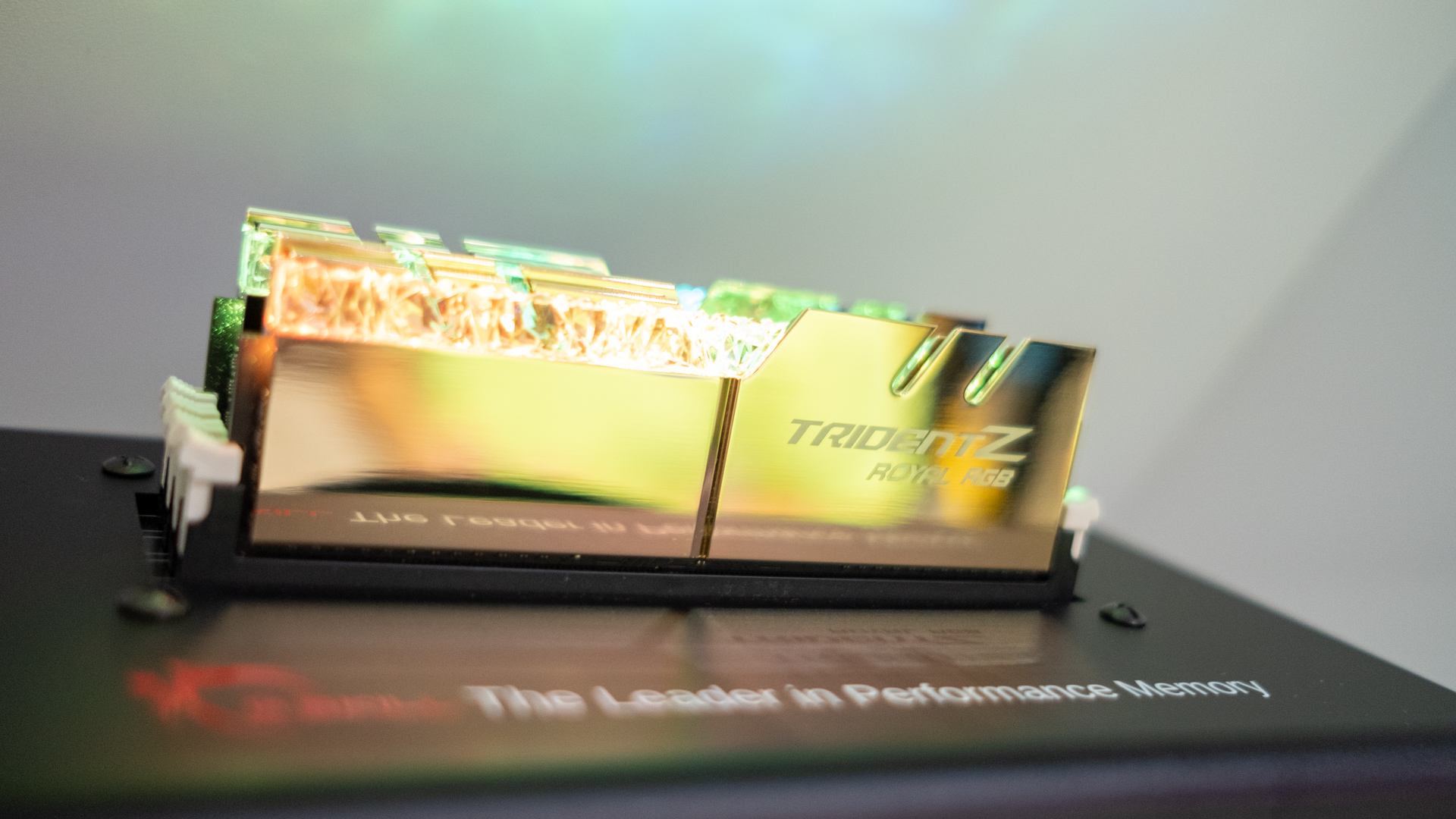
What came before?
For years, we've had RGB lighting in all kinds of accessories, components and peripherals. These days, it's not out of the ordinary to see PC cases covered front to back in bright lighting, or liquid CPU coolers lighting up the center of your motherboard.
We're already at a point where, if you know how to build a PC, you can create a truly eye-catching system. Sure, there are some people already that are like old men shaking their sticks at the clouds saying it's too much, but we can certainly see the appeal. Why wouldn't you want to build a PC that demands attention? After all, you put a lot of time (and money) into your PC build, so you should want to show it off with pride.
Still, even within this last year, we've started to see PC gaming chairs with RGB lighting, not to mention headsets and gaming monitors. Are we going to get to a point where literally everything has RGB lighting?

Literally everything has RGB lighting
Well, at Computex 2019, we got a glimpse into the future of computing, and, yeah: everything pretty much has RGB lighting. From M.2 SSDs from Adata to Asus' bizarre new Prime Utopia motherboard that has a touch screen for some reason, we're finally approaching peak RGB.
In fact, one thing we noticed while perusing through all the booths at the Taipei computing convention is that finding products that don't feature RGB lighting was harder than finding products that do.
One of the booths that stood out the most to us was Noctua, a manufacturer focused on fans and cooling. We were practically buried under a mountain of RGB fans at Computex, so when we toured its booth and saw a bunch of understated and practical designs, we took notice.

Where do we go from here?
To be honest, in the future, we see RGB lighting getting more over the top. We keep hearing horror stories about how PC sales are down, as more everyday users move on to products like the iPad Pro for their computing needs.
However, PC gaming hardware continues to go up – Nvidia even said at its press conference that more people are buying gaming laptops than ever before. And, because RGB lighting is obviously something that PC gamers go for, we're think we'll see many more PC hardware manufacturers strapping their products with as much RGB lighting as will fit.
There will always be a market for more subdued PC hardware, but RGB lighting is the mainstream now, and the more low-key, stealthy builds are going to be niche products. Not that there's anything wrong with that.
Is there a problem?
We get it. People like RGB lighting, and it only makes sense that more manufacturers will try and capitalize on that. We actually don't think there's anything wrong with building a system with maximum RGB.
It's just striking that it's become such a huge thing over the last few years. we might just be old, but we remember when RGB lighting was noteworthy, rather than something that's expected on every peripheral.
As much as we like building RGB-strapped systems, there is a sizable group of people that prefer PCs that blend into the background. And, while there will always be manufacturers that cater to that audience, it's getting harder and harder to find high-quality PC components that don't have some kind of lighting.
But, hey, who knows, we might see something come out in the next couple years that changes the style of the best gaming PCs – nothing stays in style forever after all. We know that we're excited for future Computex events to see what the future of PCs will look like. We'll see you there.
- Check out all of TechRadar's Computex 2019 coverage. We're live in Taipei to bring you all the breaking computing news and launches, plus hands-on reviews of everything from fresh laptops and desktops to powerful new components and wild overclocking demonstrations.
from TechRadar: computing components news http://bit.ly/2WgsdbV
via IFTTT
Thursday 30 May 2019
Noctua Shows Off Fanless CPU Cooler, 140mm A-Series Fan and More
 At Computex, Noctua showed off a number of upcoming cooling technologies, including a Fanless CPU cooler and its 140mm A-series fan.
At Computex, Noctua showed off a number of upcoming cooling technologies, including a Fanless CPU cooler and its 140mm A-series fan.from News Tom's Hardware http://bit.ly/2QCu1pB
via IFTTT
GIGABYTE X570 Aorus Xtreme: 16-Phase Flagship with Passively Cooled Chipset
At Computex 2019, GIGABYTE revealed various motherboard models design on AMD's X570 chipset. Its flagship, the X570 Aorus Xtreme focuses on high-end performance and is targeted at enthusiasts with a 16-phase power delivery, triple PCIe 4.0 M.2, Wi-Fi 6, and an uprated onboard solution.
The GIGABYTE X570 Aorus Xtreme takes a different approach to the rest of its X570 SKU list in that it's focused primarily on offering a comprehensive power delivery for users looking to overclock the latest Ryzen 3000 series processors. Across the majority of the boards we get Aorus themed armor where each of the three PCIe 4.0 M.2 slots heatsinks is embedded into the design. The chipset heatsink onboard the X570 Aorus Xtreme is also one of the only models so far that relies on passive cooling; we know that the X570 chipset will run warmer than the previous X470 chipset due to a higher power draw. On the rear panel cover is an Aorus Falcon design, with multiple areas with RGB LEDs that users can customize with the Aorus RGB Fusion software.
There are three full-length PCIe 4.0 slots with no PCIe 4.0 x1 slots featured on this model. One of the aspects GIGABYTE has focused on other than the impressive 16-phase power delivery is the onboard audio solution. Adding to the implementation of a Realtek ALC1220 HD audio codec is an ESS Sabre 9218 DAC, with WIMA audio capacitors. The board has a dedicated power and reset switch located at the top right of the PCB, and also features a right angled 24-pin 12 V ATX motherboard power input; the CPU uses two 8-pin 12 V CPU power inputs.
It is no secret that motherboard vendors are focusing heavily on its models ahead of the launch of X570. The GIGABYTE X570 Aorus is an example of just that with a high-end feature set and Wi-Fi 6 connectivity as well as Bluetooth 5. The biggest omission is the lack of any high-end wired networking supported; the board itself only has a single gigabit LAN port.
The GIGABYTE X570 Aorus Xtreme will be available at launch, although there are no details at present in regards to pricing or availability.
| Want to keep up to date with all of our Computex 2019 Coverage? | ||||||
 Laptops |
 Hardware |
 Chips |
||||
| Follow AnandTech's breaking news here! | ||||||
from AnandTech http://bit.ly/2MtlQNI
via IFTTT
